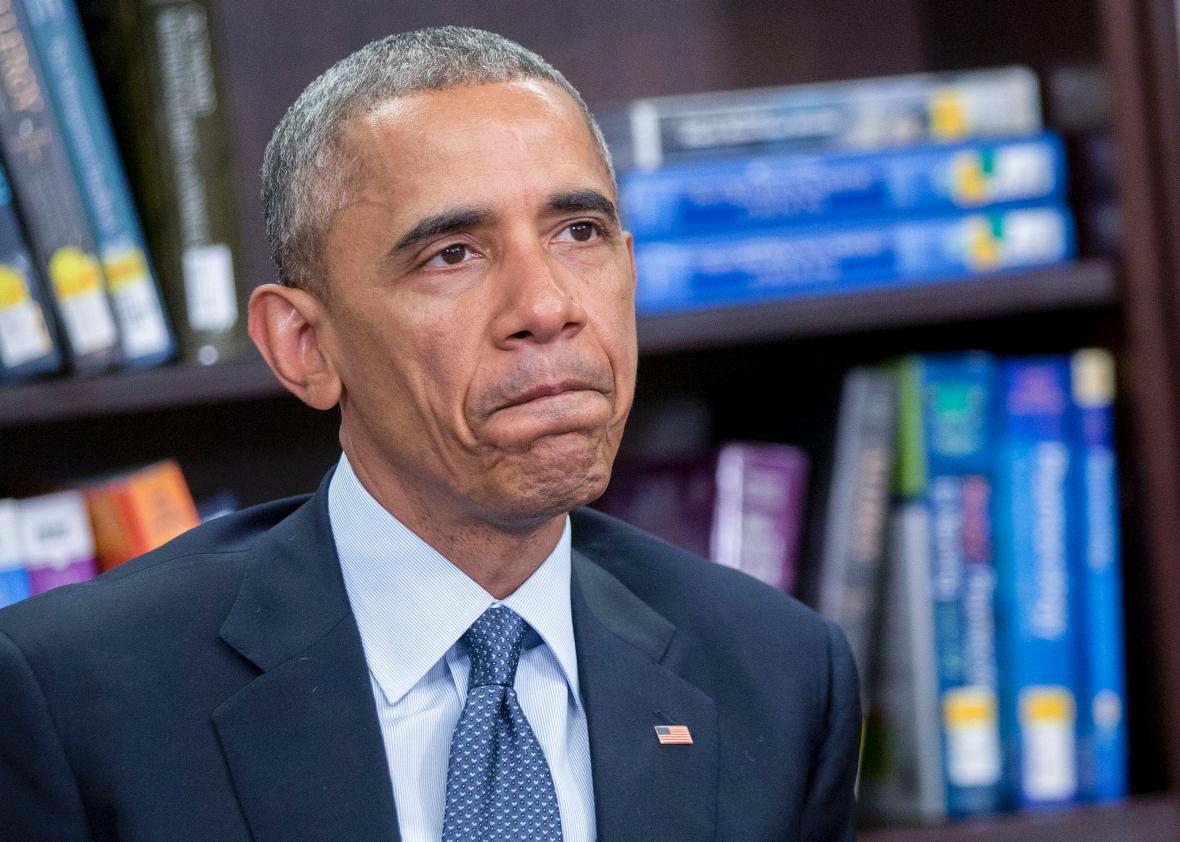On Monday, President Obama will unveil the final version of the centerpiece of his climate legacy, the Clean Power Plan. The rule is designed to speed up the retirement of the nation’s fleet of coal-fired power plants—the most carbon-intensive way of creating electricity—and could more than double the rate of coal plant closures by 2040.
In a video preview of the new rule, Obama called the Clean Power Plan “the biggest, most important step we’ve ever taken to combat climate change.” While that statement may be true, it’s not saying a whole heck of a lot.
As I wrote last year when the rule was initially announced, many states are already well on their way to achieving the required reductions, thanks in part to a recent boom in cheap natural gas and the Obama administration’s choice of 2005 as the basis year for cuts, which was close to America’s all-time peak in carbon emissions. Obama’s plan is significant, but it’s not bold.
A previous version of the targets, announced last year, would have required states to begin implementing changes to their power-producing mix in 2020. The final rule, to be announced Monday, gives states and utilities an extra two years, until 2022. The targets will vary by state, depending on their current energy mix, and states will have flexible ways of achieving emissions reductions, including an option to join an interstate cap-and-trade scheme.
All this will be a heavy lift for some coal-intensive states, like Wyoming, but it’s being heralded as largely “business as usual” for some states, like Minnesota, that have already made significant efforts to shift their energy mix.
According to the New York Times and the independent Climate Action Tracker website—which helps keep world leaders honest in the run-up to this year’s possibly pivotal international climate negotiations in Paris—the new rule puts America on a middling emissions-reduction pathway, at best.
Vox’s Brad Plumer has calculated that the president’s rule would shave just 6 percent from U.S. carbon emissions by 2030. Climate science and international equity demand the U.S. cut emissions 80 percent by then. We’re nowhere near that pace.
Still, this plan is not nothing. In its coverage, the Times includes this hopeful gem:
But experts say that if the rules are combined with similar action from the world’s other major economies, as well as additional action by the next American president, emissions could level off enough to prevent the worst effects of climate change.
That’s a lot of hedging on which to base a climate legacy.
In fact, when compared with the climate plans of his would-be successors on the left—Hillary Clinton, Bernie Sanders, and Martin O’Malley—Obama’s ranks last in terms of ambition. Clinton, who has frequently aligned herself with the president on climate, announced a preview of her own climate plan last week. It’s fractionally more ambitious than Obama’s, but it essentially just kicks the can forward another few years.
And as Slate’s Daniel Politi writes, there’s no guarantee the plan will endure in its current form after the president leaves office. Obama’s plan faces a phalanx of attacks from the political right, and legal challenges—which may take several years—could find their way to the Supreme Court. Obama has vowed to veto any actions to weaken it from a hostile Congress as long as he remains in office. As Jason Plautz of National Journal writes, the next president may not be so climate-friendly, so the ultimate fate of Obama’s climate legacy will be in the hands of others.
In a video touting the new climate rule, Obama’s lead environmental advocate, EPA Administrator Gina McCarthy, said that if the rule moves forward, “We’ll know we’re doing all we can, together, to take action against climate change.” That’s simply not true. We can, and should, do much more.
Last week, former NASA climate scientist James Hansen, fresh off a dire new warning about global sea levels, had harsh words for the slow, incremental progress that’s formed essentially the entirety of American’s climate ambition to date. “We have two political parties, neither one of which is willing to face reality,” Hansen told the Guardian. “Conservatives pretend it’s all a hoax, and liberals propose solutions that are non-solutions.”
“It’s just plain silly,” said Hansen, speaking specifically of Clinton’s planned renewable energy push. “No, you cannot solve the problem without a fundamental change, and that means you have to make the price of fossil fuels honest.”
In the end, our climate won’t care about how we fix this problem. But it’s clear that time is running out. If Obama truly wants to go all-in on climate change, he should meet Republicans where they are—as painful as that might be—and negotiate a way to pass a carbon tax. (I’m going to get a flood of email saying how naïve I am for saying that, but it’s true.)
Don’t get me wrong; the Clean Power Plan, if fully enacted as it is, would definitely help reduce our carbon emissions. But to imply that Monday’s nudge toward cleaner electricity will bring about a bold new era in American climate leadership is disingenuous. Growing economic headwinds in the fossil fuel sector—particularly in the coal and oil industries—may bring about radical change much sooner than Obama’s Clean Power Plan. If Obama really wants to make a lasting impact on global warming, he can work across the aisle or across the Pacific in Beijing, to work toward implementing a meaningful, economy-wide carbon tax as quickly as possible. Just because such a breakthrough feels impossible doesn’t mean it isn’t necessary.
